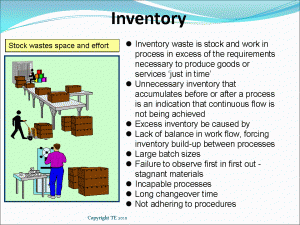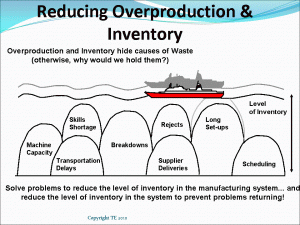The Waste of Inventory
Inventory is one of the seven wastes of lean manufacturing (or 7 Mudas). Inventory is the raw materials, work in progress (WIP) and finished goods stock that is held, we often hold far more than is required to produce goods and services when the customer wants them using Just in Time (JIT) principles.
Costs of the waste of Inventory
Every piece of inventory you hold has a physical cost associated with it, that cost is shouldered directly by yourself either from your cash or from borrowings for which you will be charged interest. Remember that for any business “cash is king”, if you tie it up in inventory it is not available for you to use elsewhere in your business.
In addition to the physical costs of your inventory you also have a host of less obvious costs that are cut directly from your profit, these are areas such as the transportation and movement of this inventory, the space required to store it, the containers to store it in, the administration of keeping track of it, the damage and losses that occur during transportation, the cost of writing off materials that become obsolete, even the costs of insuring it.
There are many costs associated with this inventory, some not as obvious as others, it causes your lead times to be increased as well as your costs, this can lead to customers being dissatisfied and taking their business elsewhere.
Inventory hides other forms of waste
One of the reasons for overproduction is a mistrust of our suppliers, process and even our customers that causes us to put in place “comfort stock” to give us a buffer if things don’t go according to our plans; plans that are often wrong!
Because this comfort stock is in place it buffers against the problems that occur so that they fail to give us the “pain” that they would otherwise, this leads us to ignore those problems as they are not important! But these are all costing us money!
The level of inventory is like the sea, if you drop that level then you begin to expose the rocks below and have to act to either remove them or reduce their size so the ship of production can continue to sail on without being sunk!
Causes of the Waste of Inventory.
The main causes of the waste of inventory is that of the waste of overproduction, making more than the customer wants or in advance of customer demand, these two wastes are heavily interlinked and you should read up on the waste of overproduction.
It can also be caused by poor layout and lack of balance in your workflow causing inventory to build up before or after different processes. This is a good indication of poor flow within your processes and one that a good lean practitioner will look for when observing your organization.
Examples of wastes of Inventory
Inventory can be observed in many areas of a business, as either raw materials that have been ordered in excess of customer requirements due to mistrust of suppliers or to take advantage of “bulk discounts” to the large amounts of finished goods sitting in your warehouse just in case a customer orders them.
In addition to this we can see levels of inventory building up in front of processes that are slower than the preceding processes and visa versa. We also see large batches of materials being moved around due to machine setups requiring us to run over sized batches to ensure we make good use of our machines.
How to eliminate or reduce Inventory
The first thing is to work to the main principles of lean manufacturing, making value flow at the pull of the customer, the idea of Just in Time (JIT) production. This will cause us to remove the main cause of inventory that of overproduction.
Look at factory and cell layout and balance your production processes to ensure that work in progress does not build up between processes, it is not important to run every machine as fast as it can be run, at the end of the day we only need to make things as quickly as the customer wants them, no faster; takt time (the time interval between customer call off) and Kanban can be used to help ensure that we balance our processes and prevent the build up of inventory.
Inventory as I have already mentioned hides all other problems, even if you implement flow with Kanban systems you should look to continue to keep dropping your inventory (comfort levels) to expose more and more of the rocks enabling you to make your processes more and more reliable.
Increase Your Profits by eliminating the Seven Wastes
By eliminating or reducing any of the wastes of manufacturing you can enhance the profits of your company, after all; every dollar saved is a dollar back on the profits. So by eliminating or reducing the causes of Muda, Muri and Mura we can reduce waste, reduce costs and improve our profits. You can use the principles of lean manufacturing in conjunction with lean tools to gain the benefits of lean manufacturing and drive the reduction in the seven wastes;
- The waste of Transportation which is the movement of product from one area to another.
- The waste of waiting which is waiting for product or information, or working slowly so as not to show a lack of work.
- The waste of Motion which is the excessive movement of people or machines within the work space.
- The waste of Overproduction which is producing in advance of requirements or in too great a quantity.
- The waste of Over-processing which is doing more than the customer has asked for.
- The waste of Defects which are parts or services that fail to meet customer needs.
- The waste of Resources which is failing to make good use of your electricity, gas, water and any other resources.
- The waste of creativity which is the failure to respect and involve your staff within the business.




1 comment for “Waste of Inventory; causes, symptoms, examples, solutions”